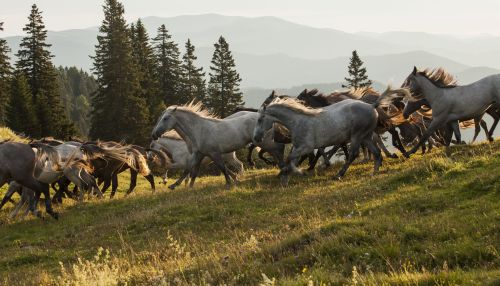#maneuver
I have loved horses since I can remember. I first rode when I was surprised on my 6th birthday with a trip to a local riding arena. When my Mom first told me we would be going to see horses, I cried. I was both excited and scared to be so close to something so big and powerful.
Since then I’ve ridden all over the place with different farms and trail companies, and have even had the chance to volunteer with one of the best-run horse rescues in the nation, Days End Farm Horse Rescue. The relationship between human and horse consistently amazes me. This brings me to one of the most impressive and well-known human-horse relationships: the Lipizzaner horses and their trainers at Vienna’s Spanish Riding School.
Today’s Lipizzan horses first originated in Northern Africa about 2,000 years ago as the Spanish Andalusian. It was a strong, sturdy, yet agile horse built for war, and these characteristics were carefully maintained by breeding in different qualities from Arab and Oriental horses over hundreds and hundreds of years. The Spanish began export of their prized horses after they broke free from the Moors. Eventually, Archduke Maximilian of Austria got hold of some breeding stock in the 1560s. The name Lipizzan comes from the horses bred at the royal stud farm founded in Lipizza in 1580 by Archduke Charles, just near Trieste in modern-day Northern Italy. Breeders continued to monitor the horses’ characteristics and made sure to bring in fresh stock from branches of the original line, until the group in Lippiza was split in two. One half went to Vienna, the other to Kladrub (modern day Czech Republic). The Kladrub is its own breed.
In 1918 the Austrian empire broke apart, and the remaining herd was further divided. One half remained in Lipizza, which now belonged to Italy. The second half went to Piber stud farm in Austria.
The Piber farm is like heaven for horses. The first four years of their lives, the stallions are allowed to run free in the fields. They have contact with humans of course, but not yet to the level of dressage training that those admitted to the Spanish Riding School experience. It is noted that many Lipizzaner’s start out very dark (brown or black) and actually change to a white coat by the time they are 6 or 8 years old. They begin their training at about 4 years of age, and continue to train for at least 6 years before they are permitted to perform. That is why most horses seen at such performances are a beautiful white.
The nature of the breed combined with careful and gentle training and handling creates a responsive and often eager performer. The horses learn a number of maneuvers, including balancing and hopping on their rear legs (Courbette), leaping into the air and kicking out the rear legs (Capriole), and even turning in a half or full circle while balancing on their back legs (Pirouette).
Photo Credits: ©Stefan Seelig, ©ScienceVision, ©René Van Bakel, acflondon.org, SPANISH RIDING SCHOOL-FEDERAL STUD PIBER GÖR, ©Herbert Graf
thanks to lipizzaner.com, PBS’s NATURE documentary “Legendary White Stallions”
Post link







